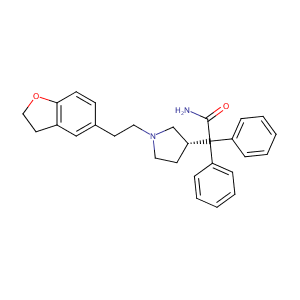Drug Information
| Drug General Information | Top | |||
|---|---|---|---|---|
| Drug ID |
D0Y5AM
|
|||
| Former ID |
DAP001131
|
|||
| Drug Name |
Darifenacin
|
|||
| Synonyms |
Enablex; Emselex; 133099-04-4; UNII-APG9819VLM; UK-88525; APG9819VLM; CHEMBL1346; CHEBI:391960; (S)-1-(2-(2,3-Dihydro-5-benzofuranyl)ethyl)-alpha,alpha-diphenyl-3-pyrrolidineacetamide; 2-[(3S)-1-[2-(2,3-dihydro-1-benzofuran-5-yl)ethyl]pyrrolidin-3-yl]-2,2-diphenylacetamide; darifenacine; [3H]darifenacin; 2-{(3S)-1-[2-(2,3-dihydro-1-benzofuran-5-yl)ethyl]pyrrolidin-3-yl}-2,2-diphenylacetamide; NCGC00168775-01; Darifenacin (USAN/INN); Darifenacinum; Darifenacina; Darifenacin [USAN:INN:BAN]; Emselex; Emselex (TN); Enablex (TN)
Click to Show/Hide
|
|||
| Drug Type |
Small molecular drug
|
|||
| Indication | Overactive bladder [ICD-11: GC50.0; ICD-10: N32.8] | Approved | [1], [2], [3] | |
| Therapeutic Class |
Urinary antispasmodics
|
|||
| Company |
Norvatis Phamaceuticals Corporation
|
|||
| Structure |
 |
Download2D MOL |
||
| Formula |
C28H30N2O2
|
|||
| Canonical SMILES |
C1CN(CC1C(C2=CC=CC=C2)(C3=CC=CC=C3)C(=O)N)CCC4=CC5=C(C=C4)OCC5
|
|||
| InChI |
1S/C28H30N2O2/c29-27(31)28(23-7-3-1-4-8-23,24-9-5-2-6-10-24)25-14-17-30(20-25)16-13-21-11-12-26-22(19-21)15-18-32-26/h1-12,19,25H,13-18,20H2,(H2,29,31)/t25-/m1/s1
|
|||
| InChIKey |
HXGBXQDTNZMWGS-RUZDIDTESA-N
|
|||
| CAS Number |
CAS 133099-04-4
|
|||
| PubChem Compound ID | ||||
| PubChem Substance ID |
7979027, 10944518, 14856314, 17397751, 36887144, 46508104, 50070895, 50113277, 50275204, 81145912, 85083117, 85583237, 92719451, 103435149, 104004586, 104631174, 126620787, 126651550, 128126220, 134338376, 135030473, 135650160, 135651146, 136947991, 137004287, 142807983, 144240344, 152047381, 160963842, 163621141, 163686486, 164826587, 175268333, 179149827, 186007015, 196107254, 223541474, 223831811, 226439188, 241032006, 249858507, 251916719, 251917958, 252215250
|
|||
| ChEBI ID |
CHEBI:391960
|
|||
| ADReCS Drug ID | BADD_D00584 ; BADD_D00585 | |||
| SuperDrug ATC ID |
G04BD10
|
|||
| Interaction between the Drug and Microbe | Top | |||
|---|---|---|---|---|
| The Abundace of Studied Microbe(s) Regulated by Drug | ||||
| The Order in the Taxonomic Hierarchy of the following Microbe(s): Eubacteriales | ||||
|
Studied Microbe: Eubacterium rectale
Show/Hide Hierarchy
|
[4] | |||
| Hierarchy | ||||
| Abundance Change | Decrease | |||
| Experiment Method | High-throughput screening | |||
| Description | The abundance of Eubacterium rectale was decreased by Darifenacin hydrobromide (adjusted p-values: 1.02E-03). | |||
| References | Top | |||
|---|---|---|---|---|
| REF 1 | URL: http://www.guidetopharmacology.org Nucleic Acids Res. 2015 Oct 12. pii: gkv1037. The IUPHAR/BPS Guide to PHARMACOLOGY in 2016: towards curated quantitative interactions between 1300 protein targets and 6000 ligands. (Ligand id: 321). | |||
| REF 2 | Natural products as sources of new drugs over the last 25 years. J Nat Prod. 2007 Mar;70(3):461-77. | |||
| REF 3 | 2004 approvals: the demise of the blockbuster. Nat Rev Drug Discov. 2005 Feb;4(2):93-4. | |||
| REF 4 | Extensive impact of non-antibiotic drugs on human gut bacteria. Nature. 2018 Mar 29;555(7698):623-628. | |||
| REF 5 | Characterisation of [3H]-darifenacin as a novel radioligand for the study of muscarinic M3 receptors. J Recept Signal Transduct Res. 1997 Jan-May;17(1-3):177-84. | |||
| REF 6 | M(1) and M(3) muscarinic receptors are involved in the release of urinary bladder-derived relaxant factor. Pharmacol Res. 2009 May;59(5):300-5. | |||
If You Find Any Error in Data or Bug in Web Service, Please Kindly Report It to Dr. Zhou and Dr. Zhang.

